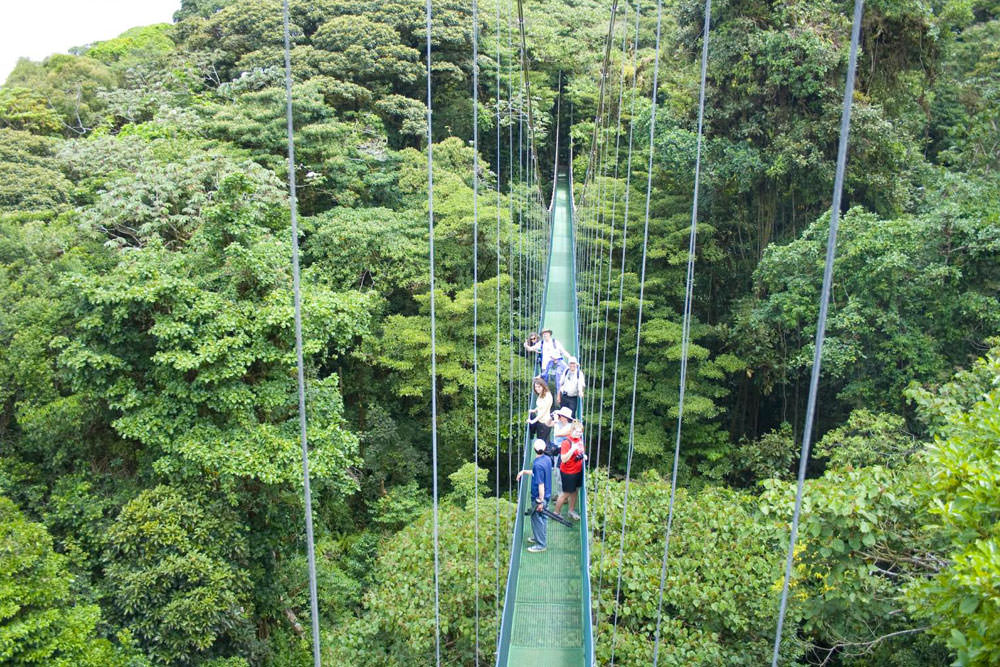
To reach the reserve follow the Interamerican Highway north from San Jose to milepost 149 Km. Just before crossing the bridge over the Lizard, turn right and continue 40 km down the road ballast. For those using public transport, a bus leaves for Santa El
The Monteverde area in Costa Rica is famous worldwide for its cloud forest. This wildlife area has been created to protect the flora, fauna and water resources, and to conduct scientific studies as both environmental education programs.
There are now two reserves, the Reserve Rainforest Monteverde original and the new Rainforest Reserve Santa Elena. In these forests you can enjoy the climate of the rainforest and a walk along the paths between the varieties of plants and magnificent trees Carague are about 450 species of birds in the Monteverde area. In a time of year for the native birds will be joining those who migrate from North America. The respladecientes quetzales with long queues at several places in the area and sometimes one can hear the "bong" of the bell birds. These areas are located in the mountains at an altitude of slightly above 2000 meters. They protect and provide habitat for hundreds of species of plants and animals.
The Reserve has earned international recognition as one of the wildlife sanctuaries in the highlights of the New World tropics. Strategically located on both sides of the line of inland waters in northwestern Costa Rica, the reserve extends over the slopes, Caribbean and Pacific. The combination of geographical and climatic factors produce rates of temperature and humidity vary dramatically over very short distances.
The abundant rainfall and permanent (3000 to 5000 mm.) On the front and eastern boundary of the range, eat plenty of rivers, all tributaries of the River San Juan with the name of San Carlos. In the western façade, rainfall is seasonal, 88 percent of rain falls from May to November, the river supplying Guacimal that desenboca in the Gulf of Nicoya. The river water is still in the dry season in the Pacific, because of spills trapped by clouds and mists of the dense forest reserve.
Biological Reserve Monteverde Cloud Forest is recognized worldwide as the golden toad, a species endemic deaf and without speech, typical of the watershed, whose males have a very striking orange. You can see their young from late April until early June.
WEATHER
The average annual temperature varies between 16 º C and 18 º C, and average annual precipitation is 3,000 mm.
HISTORY
The forests of Monteverde, wrapped in clouds, and his many wild creatures, they share a common future with humans that have been established around the reserve. In 1972, under the threat of colonization of the surrounding cloud forest, scientists George Powell and his wife joined the Quaker resident Wilford Guindon to establish a nature reserve. Tropical Science Center was receptive to these efforts and accepted institutional responsibility for the foundation, possession and administration of future reserves.
Initial purchase of 328 hectares formed the basis for the Monteverde Cloud Forest Biological Reserve. Administrative agreement in 1975 under the communal reserve was annexed Bosque Eterno SA Hydrographical 554 hectares, was founded in the mid-60s by members of the Quaker community.
After the creation of the Reserve, the Tropical Science Center continues to seek financial and human resources necessary to protect, expand, consolidate and manage the Reserve. Currently it has an area of over 10,500 hectares.
ADMINISTRATION AND FACILITIES
The Monteverde Cloud Forest Biological Reserve is owned by the Tropical Science Center (CCT), scientific and educational association in Costa Rica nonprofit based in San Jose and founded in 1962.
The RBBNM has facilities for up to 120 guests simultaneously. It highlights the location of 7 trails with a total length of 12.4 kilometers. There attention to visitor groups with naturalist guides. La Casona de Reserve houses the administrative offices, a restaurant, wineries and dormitory-style bedrooms for 40 visitors, researchers and students. In the lowlands on the Atlantic side has built a station to provide access to the very humid tropical forest. There are also three shelters for hikers along the reserve, which meet the basic needs of shelter.
Guided walks
We recommend that visitors using the services of naturalist guides. The reserve is open to visitors daily from 7 am until 4 p.m. throughout the year and offers an excellent walking guide and presentation slides. The walks last between 2 ½ and 3 hours, beginning each morning at 7:30 am There are also nightly walks and aviary. Reservations must be made in advance. Revenues from service guided walk is the main contribution to the Department of Environmental Education which works mainly with schools and local communities.
FLORA AND FAUNA
Six Life Zones are in the Reserve and its biodiversity includes over 400 species of birds, including the quetzal, the clandria and pavoncillo, 120 species of reptiles and amphibians, 490 butterflies, 100 mammals, some as tapir, jaguar and manigordo are endangered, 2,500 plants including 420 orchids that bloom mainly in March, 200 ferns. This biodiversity is distributed in an altitudinal range of 1,200 m. average from 660 m. on the slopes of the Caribbean to 1860 m. the summits of the hills.
Dwarf natural forests, sculptured by the wind on the exposed ridges, remain stunted, while gallery forests with majestic trees, decorated with orchids, bromeliads, ferns, vines and mosses. Areas argue imperfect drainage swamp forests, while parts of the Reserve, dissected by deep gorges, have numerous crystal clear streams with rapids and waterfalls

 English
English






